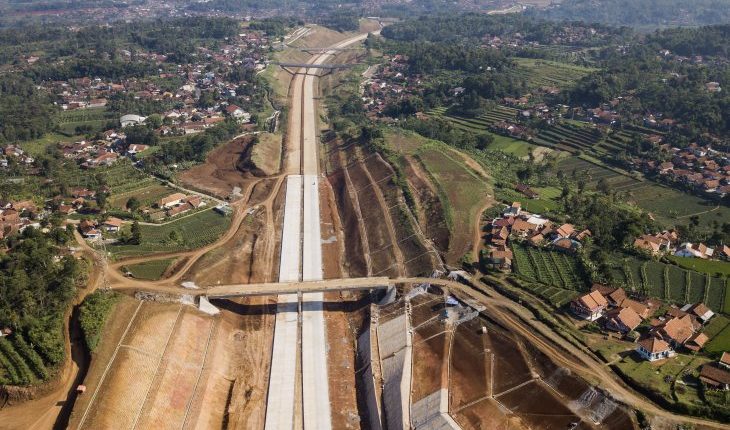Infrastructure Development Increases Agricultural Productivity
By: Agung S Budi, S.I.P, M.Sos) *
The contribution of the agricultural sector to gross domestic product during the five years of Jokowi’s leadership increased significantly by 42.5 percent and agricultural exports reached 42 percent coupled with the achievement of a national rice surplus of 2.8 million tons. This is as the government’s efforts to attract workers in the agricultural sector, although it is still experiencing a decrease of 1.2 percent per year. The solution is increasing agricultural productivity through accelerating agricultural infrastructure.
The giant dream initiated by Jokowi to build a total agricultural sector abstracted in the IMEP program has a global-scale agenda of goals, the World Food Granary in 2045, seen even more real. The big dream, like a dream when the Borobudor Temple or the Great Wall of China was built for hundreds of years. This means that the visionary of Jokowi’s planning and leaders in the 9th century has something in common in the long leap in the future.
The acceleration of total reform in the agricultural sector starts from zero, which has never been done before, namely water resistance (reservoir development) for large-scale agriculture accompanied by reservoir rejuvenation (new order era). Meanwhile, the downstream is only targeted for food security. Evidence of the seriousness of the government is reflected in the expenditure of infrastructure spending in the agricultural sector reaching Rp. 420 trillion in 2019, this figure increased by 157 percent from 2014 which only reached Rp. 163 trillion.
Water security for agriculture begins with the construction of 43 dams already operating from the target of 65 dams, the rest by the end of 2019 has been completed. As a result of the construction of a number of giant dams, the storage capacity reaches 2.11 billion cubic meters. On the other hand, the construction of reservoirs is synergized with the reform of irrigation channels throughout Indonesia, which has been built as many as 865,389 hectares (Ha). In 2019, the government will still build an irrigation network covering an area of 139,410 hectares again, thus the total accumulation of the irrigation network that will be built later, reaching 1,004,799 hectares.
Very concerned when Indonesia is known as an agrarian culture country, previously only had assets of 231 medium and small dams. Even that number is not entirely for the agricultural sector. Even more alarming about 52 percent of irrigation networks damaged and many are found in a number of points in Indonesia that have been damaged for 30 years but not repaired. Another question is, is it enough that the number of medium dams below covers around 792 hectares or 11 percent of rice fields out of a total 792 hectares, then it is worth dreaming of creating rice self-sufficiency.
Ending the chain that always covers the problems of the agricultural sector every episode of government, it seems the focus of the government is currently trying to achieve gradually self-sufficiency in rice with a strategy of strengthening the basic foundation that is currently being encouraged to reach the next leap, namely the world food barn. The key word for the government is to ensure that all projects run on time and to their functions and to minimize them from falling into the pit of the project called stalling.
Every presidential visit to all regions of Indonesia, the progress of dams, reservoirs and irrigation networks becomes the priority of Jokowi’s strict supervision, if he has not achieved progress directly evaluated. Distribution of dam construction is divided into several clusters, East Indonesia in Kalimantan built 5 dams namely Teritip that has been completed, Marangkayu, Tapin, Lambakan and Riam Kiwa. On the island of Sulawesi, nine dams were built, namely Karalloe, Lolak, Kawwilan Regional Office, Ladongi, Pamukkulu, Bolanggo Hulu, Passeloreng, Jenelata and Pelosika.
While in Bali, 3 dams were built namely Titab, Sidan and Tamblang. East Nusa Tenggara Province has 7 dams namely Raknamo, Rotiklod, Napun Gete, Temef, Mbay, Manikin and Kolhua. In West Nusa Tenggara 5 dams were built namely Tanju, Mila, Bintang Bano, Beringin Sila and Meninting. Whereas in the Provinces of Papua and Maluku one dam was built, namely Digoel Dam and Way Apu.
Accelerating the construction of dams, reservoirs and irrigation infrastructure in response to the government’s responsibility in guarding his big dreams like the 9th century visionaries who narrated the conditions, giving certainty tickets to the Indonesian people safe from the food crisis, deeper, the sovereignty of Indonesian farmers was able to expand through the market global food world.
) * The author is a researcher of the Political Economy Study of Regional Development
